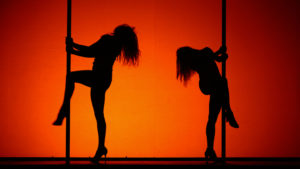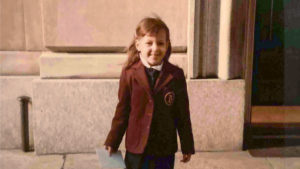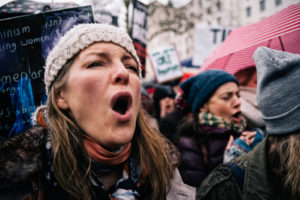Margaret Atwood never fancied herself a discourse power broker, but we thrust the role on her anyway. The year was 2016; the election of Donald Trump had sparked a brief, blazing feminist backlash that now feels like something out of a fever dream. Self-described “nasty women” in pink knitted hats snarled in furious unison at the neanderthals who put someone like that in office. “Pussy grabs back” became a religion, Margaret Atwood its patron saint: the scribe whose dystopian tale of women subjugated, domesticated and downtrodden now seemed poised to become a reality.
The Handmaid’s Tale describes a futuristic puritan patriarchy in which women have been stripped of their liberties and forced into service as child-bearers for the ruling class. A television adaptation was already in development when Trump was elected, but its arrival in the spring of 2017 felt tailor-made for the moment — and its imagery, especially those blood-red robes with their creepy, face-obscuring bonnets, was too instagrammable to resist. In June that year, the New York Times noted that Handmaid costumes had become de rigueur at protests against everything from Planned Parenthood funding cuts in Washington, D.C. to abortion restrictions in Ohio.
Meanwhile, Atwood was newly hailed as a modern-day Cassandra, one whose warnings we could no longer afford to ignore. As one Guardian columnist wrote, “The world of Offred, though still notionally a fiction, has migrated from creative construct to the realm of the thinkable.”
Atwood, it should be said, never quite bought into the vision of herself as the oracle of the Trump resistance. When pressed, her responses were invariably judicious — “We’re not living in Gilead yet, but there are Gilead-like symptoms going on”, she told one interviewer — though media coverage framed them as anything but. The most striking example of this is her New York Times retrospective on The Handmaid’s Tale, written in March 2017: the headline reads, “Margaret Atwood on What The Handmaid’s Tale Means in the Age of Trump”. The essay doesn’t mention him.
And there were hints, always, that Atwood wasn’t quite as gung-ho for the new feminism as some pretended. In 2016, she was a signatory on a letter demanding accountability in the case of Stephen Galloway, a professor who was accused of sexual assault and fired without due process by the University of British Columbia. (A defamation suit by Galloway is ongoing in the Canadian courts.) Atwood’s 2018 essay about the matter became Twitter’s outrage du jour and caused the website Vox to downgrade Atwood’s status from “feminist icon” to “problematic fave”. Atwood’s response was a bone-dry tweet:
Taking a break from being Supreme Being Goddess, omniscient, omnipotent, and responsible for all ills. Sorry I have failed the world so far on gender equality. Maybe stop trying? Will be back later. (Next incarnation maybe.)
— Margaret E. Atwood (@MargaretAtwood) January 14, 2018
Yet any qualms about Atwood’s ideological purity were eclipsed at the time by her usefulness to the movement. Simply put, people wanted to wear Handmaid’s Tale outfits in front of the Supreme Court more than they wanted to purge the author for being a little too agnostic on #MeToo.
But fast-forward to our present day: The Handmaid’s Tale has long since finished its four-season run on Hulu. The #MeToo movement is yesterday’s news. And that fervour for protecting women’s bodies — from government overreach and groping hands alike — has been increasingly replaced by a base-level discomfort with women’s bodies, not just as a discussion topic, but as a concept. By the time Atwood came under fire again, this time for retweeting an article observing the bizarre retreat of the word “woman” from the public sphere, the cultural tides had turned. The enemy in the Oval Office was gone; the feminist eye of Sauron turned inward.
And for the same movement that once hailed Atwood as a prophet because she wrote so searingly about how women’s bodies and biology become the subject of oppression, now she was vaguely suspicious — for the exact same reason.
Atwood, as usual, is not interested in what you think of her — nor in placing herself into an ideological box that would make her easy to dismiss. Her new book of essays, Burning Questions, is ironically titled: the new feminism is desperate to know Atwood’s stance on gender ideology, but in interviews, Atwood has artfully refused to be pinned down. Those looking for an answer won’t find it here.
Still, it’s hard to imagine that she’s surprised by the turn the feminist movement has taken towards purging those women, and particularly women of a certain age, who won’t toe the line on its uptake of the latest in gender ideology. Insofar as Atwood can predict the future, it’s always been because she pays attention to the past. “I believed two things. (1) That if true believers say they’ll do a thing, when they get the chance they’ll do it. (2) Whoever says “It can’t happen here” is wrong. Anything can happen anywhere, given the right conditions, as history has demonstrated time and time again,” she writes, in the essay titled “Reflections on The Handmaid’s Tale“.
And the social disposability of women who are past childbearing age and hence no longer serve any social purpose (the unspoken subtext: to men) is one of those time-and-time-again themes. From the 19th century medical consensus that menopausal women might as well die off, having outlived their usefulness, to the dearth of roles for women over 40 in Hollywood, to the shared (and oft-written-about) feeling among middle-aged women that they’ve somehow become invisible. And while feminism has long pushed back against the patriarchy that pushes older women into obscurity, it turns out we’re not above engaging in our own little litmus tests for the grande dames who won’t get with the times.
Yesterday’s feminist heroes — the Atwoods, the Rowlings, the second-wavers writ large — are today subject to interrogation about where their loyalties lie. If they don’t pass the test, into the bin they go. The new feminist wields the word “terf” to the same end as the men’s rights activists who deem us “unfuckable”, hence useless: it’s a label designed to deem its wearer irrelevant, out of bounds, voiceless.
Seen from certain angles, there’s something peculiarly optimistic about all this, as if feminism has so thoroughly won the battle for women’s bodily autonomy that it need not be our primary concern. In fact, all this discussion of women and bodies is actually offensive and unnecessary and should no longer take place (or if it must, we should at least have the decency to leave the W-word out of it and say “people with cervixes” instead). There are echoes of the past here, too: in her notoriously negative review of The Handmaid’s Tale for the New York Times in 1986, Mary McCarthy declared the novel too dystopian to be believed, an alternate history of a culture war that had already been thoroughly won. “Even when I try, in the light of these palely lurid pages, to take the Moral Majority seriously, no shiver of recognition ensues”, she wrote.
Today’s insistence that feminism should pivot away from women’s bodies and toward inclusivity and diversity suggests that The Handmaid’s Tale has been deemed an irrelevant and impossible fiction once again — even as Roe v. Wade, the landmark US Supreme Court case that legalised abortion, is facing its most serious threat in decades. One gets the sense of an army wandering off its longtime battlefield in search of a new conflict, a giant MISSION ACCOMPLISHED banner floating down to cover the few red-robed protesters still lingering at the front.

Welcome to Team TERF, Margaret Atwood
Maybe that pivot is the right choice, or maybe not; as Atwood notes, “There is no such thing as being on the wrong side of history — if history means who’s in political power and who’s not, and who’s in intellectual fashion and who’s not, because history of that kind doesn’t have sides.”
But while we’ll have to wait for the benefit of hindsight before those purged from the movement emerge in the rear-view as either traitors or martyrs, we can consider one thing now: who benefits from this moment of intra-feminist conflict? Who is watching, hungrily, as we tear each other apart?
This is the kind of question Atwood doesn’t ordinarily shy away from answering, unconcerned as she is with which ideas are currently in vogue. Not only that, it’s one she has answered, in the essay titled, “Am I a Bad Feminist?” Written for The Globe and Mail in 2018 after she ran afoul of the #MeToo orthodoxy, it is reproduced in Burning Questions — but with a curious omission: one that seems to illuminate the limits of Atwood’s bravery when it comes to the changing landscape of feminism and the issues that put us at each other’s throats. Four years ago, when the dissident feminist’s topic was the excesses of #MeToo, the last paragraph of this essay included a barn-burner of a line:
“A war among women, as opposed to a war on women, is always pleasing to those who do not wish women well.”
But that was then, and this is now — in a world where the feminist movement is tearing itself apart not over sexual mores, but gender ideology. And in the version of this essay that appears in Atwood’s new book, that final warning has been left out.
Disclaimer
Some of the posts we share are controversial and we do not necessarily agree with them in the whole extend. Sometimes we agree with the content or part of it but we do not agree with the narration or language. Nevertheless we find them somehow interesting, valuable and/or informative or we share them, because we strongly believe in freedom of speech, free press and journalism. We strongly encourage you to have a critical approach to all the content, do your own research and analysis to build your own opinion.
We would be glad to have your feedback.
Source: UnHerd Read the original article here: https://unherd.com




